1828-1911
Merchant and publisher
Frederic Lassetter transformed a small Sydney ironmongery firm into one of the city’s giant retail establishments, while retaining a firm grip on his commitment to fairness and generosity as an employer. Lassetter made the house Redleaf, Double Bay, his home, and built St Brigid’s next door for the use of family members.
Image: Frederic Lassetter. From 'Sixty Years an Employer' Lassetter & Co. Ltd, 1910.
536 New South Head Road, Double Bay
View all plaques in Double Bay
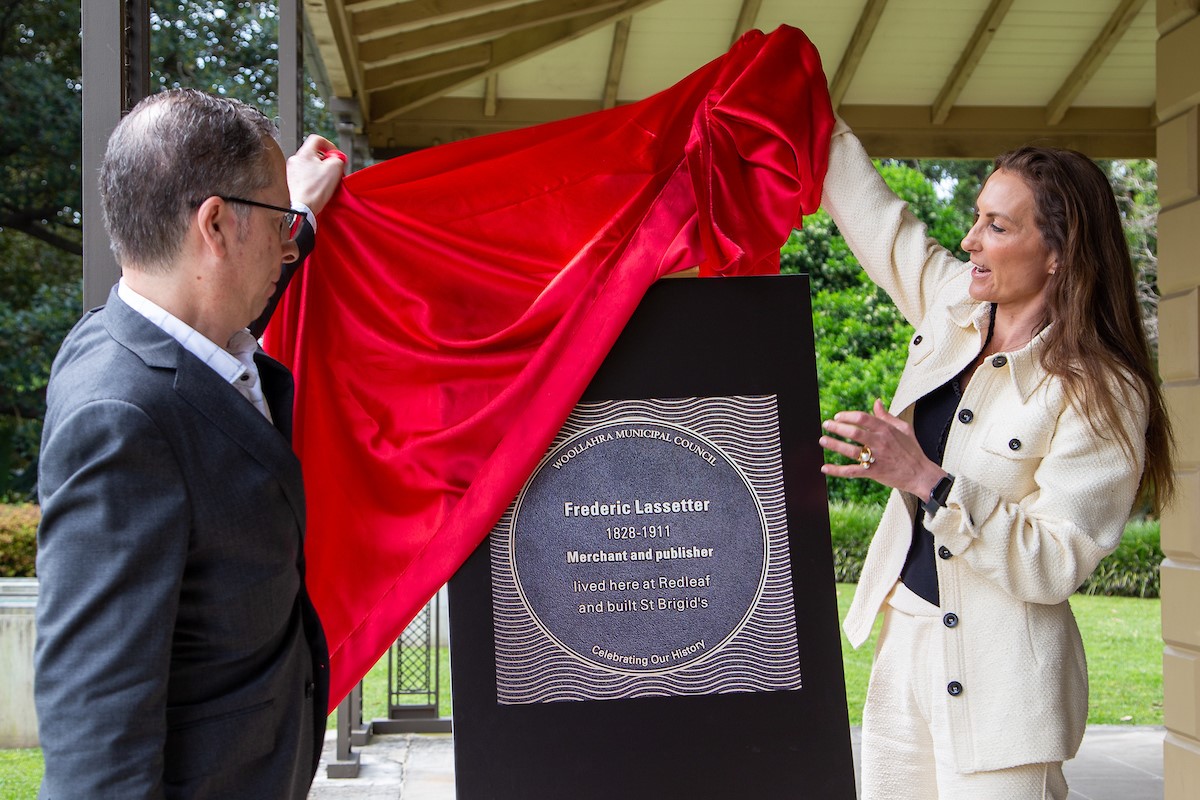
Guest speaker Michael Lech, and Cr. Susan Wynne, Mayor of Woollahra at the unveiling ceremony for a plaque commemorating the career of Frederic Lassetter, on 26 September, 2022.
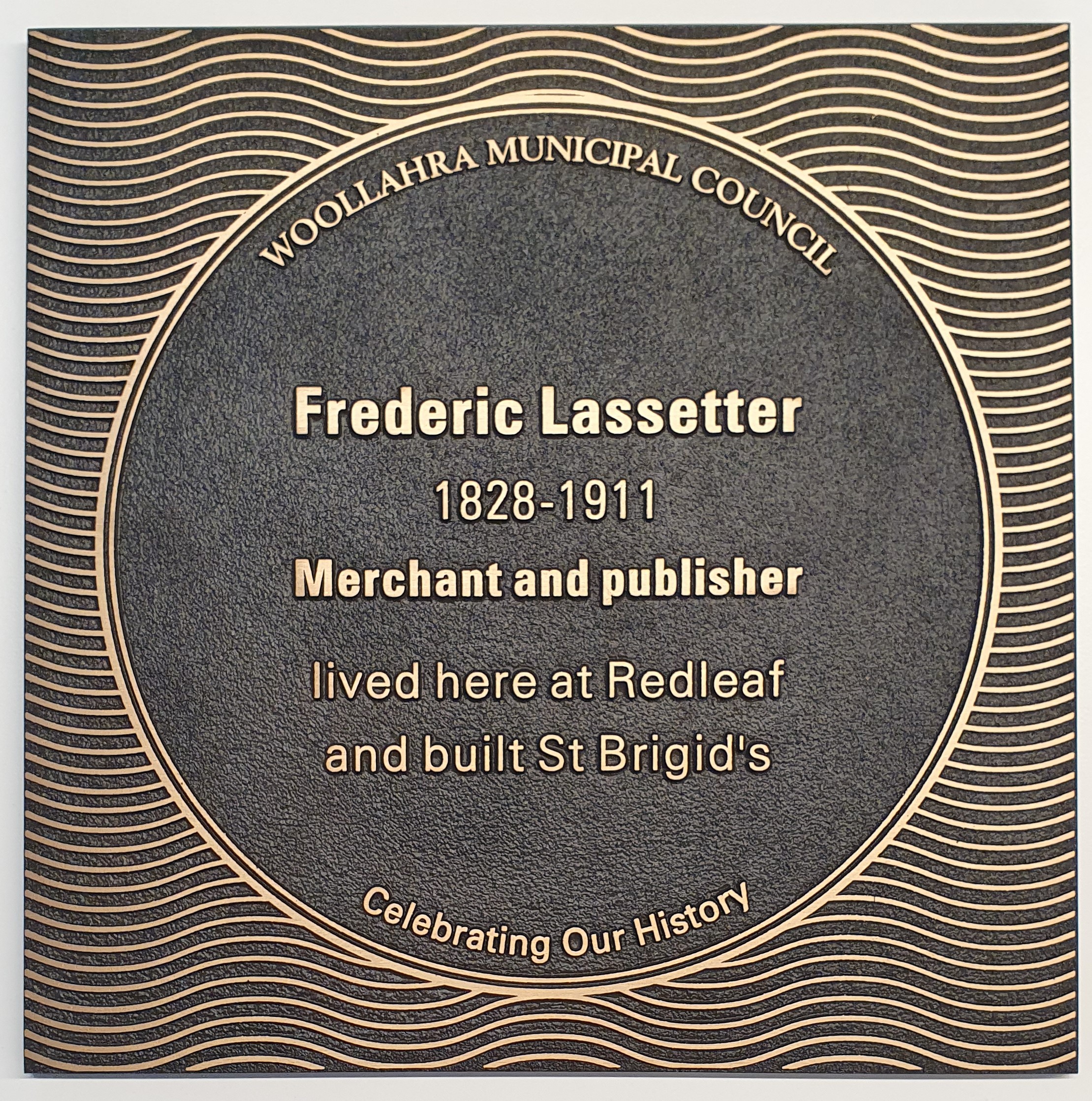
A plaque celebrating the life and career of Frederic Lassetter was unveiled on 26 September 2022 outside his former home Redleaf, at 536 New South Head Road, Double Bay. The plaque is located on the footpath on New South Head Road, between Woollahra Council Chambers (Redleaf) and the Woollahra Gallery at Redleaf (formerly St Brigid’s).
Read a copy of the speech given by guest speaker Michael Lech, Curator, Sydney Living Museums)(PDF, 120KB)
Gallery
13 December 1828 - 5 September 1911
Merchant Frederic Lassetter created a retail empire which became an institution – a presence not only in central Sydney, where its imposing headquarters fronted George Street, but a household name wherever the firm’s famous catalogues and other publications were delivered to suburban doorsteps or country mailboxes.
Competitive, driven and innovative, yet fair-minded in his approach to trade and workforce management, Frederic Lassetter developed and sustained a flourishing business, but not at the cost of exploiting his staff or compromising his integrity. For some twenty years he made his home at Redleaf Double Bay, building the neighbouring St Brigid’s during this period to house and support members of his family.

'Lassetter & Company’ New South Wales. Government Printing Office 1872, 'Photographs of Public and Other Buildings, &c' [No. 48] photographed by Charles Pickering. From the collections of the State Library of New South Wales.
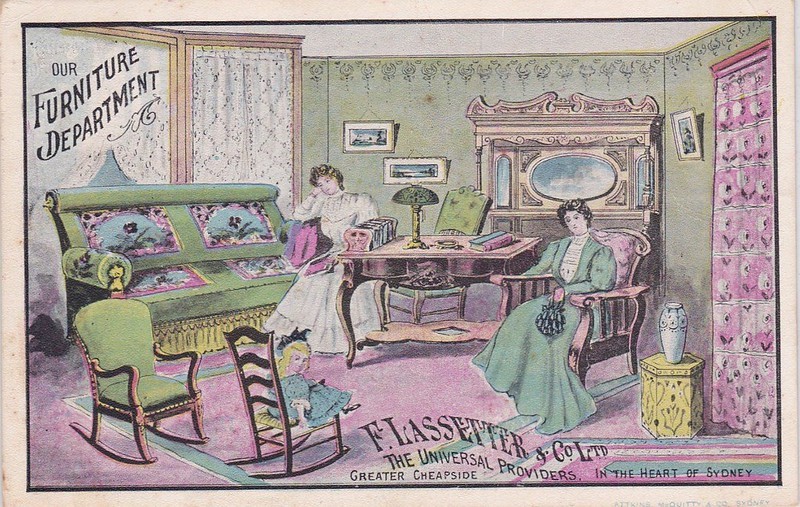
Postcard c1908 F Lassetter & Co. Ltd. Image: Flikr
Birth and family background
Frederic Lassetter was born on 13 December 1828 in Taunton Somerset, in South-west England.1
He was the eldest son of Matthew Lassetter and his wife Elizabeth Ann Lassetter, née Bedford, who had married in Brighton, Sussex in 1825.2 Elizabeth was a widow, with two daughters, Georgina and Jessie, from her first marriage to George Ford. Matthew Lassetter is noted as a school master in the record of baptism of his third child, daughter Kezia Susannah, in 1830.3 He also at times used the title Reverend, referencing his role as a Wesleyan minister. History shows, however, that Matthew Lassetter was a versatile and resilient practitioner of various completely unrelated occupations.
Following their marriage, Matthew and Elizabeth appear to have settled first in London, given their first child, Kezia Bedford Lassetter, born 26 December 1826, was baptised at the Wesleyan Southwark Chapel4, and was buried five months later at St Giles, Camberwell.5 The Lassetter’s move from London to Taunton came at some time between this family tragedy and Frederic’s birth the following year, and when a second daughter was born in 1829 – Kezia Susannah Lassetter – she was baptised at the Wesleyan Chapel in the nearby town of Bridgewater, Somerset.6 Kezia was named for her mother's two sisters. The three Bedford girls, orphaned from an early age, enjoyed a close and mutually supportive relationship – one which would continue in practical terms for Elizabeth and her younger sibling Kezia, after each independently emigrated to the colony of New South Wales.
Frederic Lassetter’s birthplace was seemingly of enduring significance to him, and over eighty years later and a world removed, is one of the few details recorded on the simple, elegant headstone that stands at Sydney’s South Head cemetery to commemorate his life. And while he left England as a young child, and in his adult life unquestionably tied himself and his interests to New South Wales, Frederic’s country of origin exerted a powerful draw upon him and his descendants. He sent his sons home to England for their education – a common enough arrangement among colonial families of means – but the family also spent periods living in London, where two of the later children of his marriage were born. Frederic himself died at his long-held family home in Sydney’s Double Bay, but most of his family ultimately resettled in England and Europe, and the family plot at South Head provided a final resting place only for Frederic, his eldest son Henry Beauchamp Lassetter, and a grandson Joseph (Joe), who predeceased Frederic in 1909 as an eight-year-old boy. The lychgate at the southern end of the cemetery commemorates his young life.
The Lassetter family’s move to the colonies
By his own account, repeated in numerous newspaper articles over the years, Frederic Lassetter was four years old when he travelled with his family to New South Wales to settle in the colonies. While this has not been substantiated in shipping records, Matthew Lassetter was clearly based in Sydney by March 1833, when his name appears as a subscriber to the cause of a ‘Committee for Promoting the Objects of the Petition for a House of Assembly’, raised by the colonial reformer W C Wentworth.7 The timing is consistent with Frederic’s version of events.
The reason for the family’s departure to the colonies is not explicitly known. Encouragement from Elizabeth Lassetter's sister Kezia, already settled in the colony and married into the Sydney-based Iredale family, would seem a likely influence. But it can certainly be presumed that the hope of fresh opportunity underpinned every other factor in the move. In this regard, the earliest sign traced of family enterprise in the Lassetters' new world came not from Matthew, but his wife Elizabeth. In May 1833, in the Sydney press, the following notice appeared under the heading: ‘Baby Linen Warehouse’
Mrs E A Lassetter respectfully informs the inhabitants of Sydney and its vicinity, that she has opened the above warehouse in William’s Place, George Street, opposite the Colonial Treasury, where she hopes by perseverance and strict attention, to merit a share of their support. Every article constantly on sale. Millinery and dress making in all its branches. NB – Country orders executed in the shortest possible notice.
The Sydney Herald 30 May, 1833 p. 1.
The retail model set out in Elizabeth Lassetter’s first advertisement bears an interesting resemblance to her son’s later approach to business, and like Frederic, albeit on a comparatively tiny scale, Elizabeth’s range and volume of stock expanded rapidly, as subsequent advertisements indicate – no longer limited to baby linens but embracing finery for all age groups. Frederic Lassetter always maintained that his mother was a major influence on his life, and while he was a small child during the years of this operation, it is likely he later drew on what he knew of it.
In January 1834, Mrs E A Lassetter announced that she was moving her 'Baby Linen Warehouse’ to a new premises at 12 King Street – apparently translating into an expansion in space.8 She was joined at the King Street address by Matthew, who opened a new dining establishment.
Mr. Lassetter, we perceive, has opened a respectable pastry cook's shop in King-street, where luncheons, dinners, and soups of all kinds can be supplied at a very short notice, in the first London style, and at a trifling charge. Mr Lassetter’s premises are commodious, enabling parties to hire private accommodation if required. An establishment of this kind is much wanted in Sydney, and as it is in good hands, we have no doubt of its meeting with a fair share of public patronage.
The Sydney Gazette and New South Wales Advertiser 11 January, 1834 p. 2.
Newspapers of the era prove that Elizabeth and Matthew appreciated the worth of advertisement, issuing regular reminders to their public of the evolving offerings from No 12 – new menu options from one side of the business, and goods of increasing diversity from the other. This sound grasp of promotion was a legacy bequeathed to their son Frederic, who would take it to great heights in his own business, thirty years later.
Matthew Lassetter did not reserve all his energies for business. His name is among those of the founding committee of the Sydney Stranger’s Friend Society, a benevolent organisation loosely affiliated to religious institutions and individuals of the colony, formed in January 1835 with the object of providing assistance to ‘sick and distressed persons’ in their homes.9 Later, in years spent in Launceston, Matthew was involved in the local chapters of various Wesleyan-based or non-denominational Christian organisations such as the Bible Society and, in particular, the Temperance movement.
From Sydney to Launceston
Despite the Lassetter family’s apparent engagement with life in Sydney, within a few years they had moved on to the colony of Van Diemen's Land, where Matthew Lassetter pursued numerous livelihoods in an extraordinarily swift succession. The family was based in Launceston by early 1836,10 where Matthew opened a bakery.11 In 1837 he took the opportunity to return to his original occupation as a schoolmaster, appointed alongside Elizabeth as the Master and Mistress of the Launceston Infants School, and balancing these duties with the continuing bakery operations.12
Late in 1838 Matthew resigned from his post at the school,13 and in early 1839 found new premises to open a mixed pastry and confectionery business,14 which he sold to one of his former employees in November 1840.15 There is some evidence to suggest that in late 1841 Matthew was back in Sydney, running the Edinburgh Castle Hotel,16 before a return to Launceston and a re-affirming of his Temperance pledge twelve months later.17 Nebulous references are found from 1843 to Lassetter’s ‘farm’, and a ‘commercial coffee room’ was set up or revived from an earlier business at some point during this period. Then, in July 1845, Matthew Lassetter was granted a licence as an auctioneer,18 and by October 1845 he was seeking an ‘industrious couple’ to lease his coffee rooms, given he was ‘intending to devote in future the whole of his time and attention to his business as an Auctioneer.’19
Evidence of the effect that this peripatetic career had on the childhood of Matthew’s son Frederic, and the impression it made on him as he entered his own working life, has not been found among those reminiscences publicly shared by Frederic and his family. Nor has the family’s experiences of the 1840s depression been traced, but it is likely that these were among the influences that shaped the businessman who Frederic became.
Childhood, education and first steps into the working world
During the family’s Sydney years, Frederic attended Timothy Cape’s Sydney College, according to an obituary published for Frederic which cited his son Harry Beauchamp Lassetter as its source. It was claimed that Frederic was at first at the bottom of his class (the top position held by Walter Lamb) but that his perseverance earned him a school prize, treasured as a family heirloom.20
Frederic would have been aged approximately eight years old when the family moved to Van Diemen's Land, and details of the schooling he received after that have not been discovered.
The story of his experience at the Sydney College is consistent with what is known of Frederic’s general determination to fulfil his potential, and the fact that he went to great lengths to secure each of his sons a formal education of unquestionable standard is no doubt revealing about his stance on its value. However, whether by circumstances or natural inclination, Frederic seems not to have aspired to academia, but to more directly practical pursuits, for which he showed both readiness and aptitude.
It is likely that Frederic was involved in assisting his father in many of his ventures, and possibly from an early age. It was remarked in an obituary,
While still a child Frederic Lassetter was initiated into the ways of farming – even when a lad, he practically managed his father’s farm
'All About People', The Catholic Press 7 September, 1911 p. 22.
The farm appears have been part of a glebe, but the arrangements by which the family held and worked it are unknown.
Frederic also no doubt received his first experience in the world of auctioneering as a consequence of Matthew's pursuit of that line of work. The auctioneering world would have given him an early understanding of commercial practice, and perhaps can be credited with indirectly leading him, some years later, to his profitable, life-long association with Sydney auctioneer George Alfred Lloyd. Auctioneering was the first work Frederic is known to have pursued as a fifteen year-old, when he struck out alone for Melbourne - prior experience his only likely edge, as an unknown seeking employment in a new city. Nevertheless, the fact that Frederic acquitted himself so ably in his early working life was essentially due to his ability and his sense of duty to his employers, a factor over and above anything he owed to his father’s tutelage.
The Lassetter family’s domestic life would have been another shaping force in Frederic's youth. It is likely he assumed family and household responsibilities as he entered late childhood. The arrival of two new siblings, born during the family’s Tasmanian years, would have redefined him as an older brother. The additions were Elizabeth Weiss Lassetter (who was always known as Louise, or Louey) in 1836,21 and Henry Charles Lassetter, in 1839.22 With many sources noting that Frederic was exceptionally close to his mother, he almost certainly would have chosen to direct some of his energy and capability towards supporting her.
The year 1844 spelt tragedy for the family in two separate losses. On 25 May, the five-year old Charles Lassetter died at 'the Glebe Farm, Norfolk Plains Longford' after a short illness.23 Three months later, on 26 August, 15-year old Frederic and his eight-year old sister lost their 49-year old mother.24 It would have been a time of family upheaval and personal devastation for Frederic. According to his biographer, Frederic left for Melbourne the following year, and found work in an auctioneering firm.25The move was presumably as much a reaction to his personal loss as to his ambition to succeed on his own terms.
Two years later, in August 1847, Matthew Lassetter married Anne Eustace in the Wesleyan Chapel Launceston,26 and in 1850 moved to California.27 While the years from Elizabeth Lassetter’s death can be seen as a period marked, in stages, by ‘partings-of-the-ways’ for the family, it did not signal permanent estrangement.
Frederic clearly maintained a close relationship throughout his adult life with his surviving sibling ‘Louey’. In January 1855, when she married Sydney merchant Henry Herron Beauchamp, the Wesleyan ceremony was conducted at the home of her brother Frederic and sister-in-law Charlotte Lassetter, at Radnor Place Surry Hills.28 The Lassetter and Beauchamp families lived for years in close proximity at Kirribilli, and Frederic and Charlotte Lassetter’s firstborn son was named Henry Beauchamp (Harry).
Louey Beauchamp’s youngest daughter, Mary Annette, went on to become a well-known author, writing under the pseudonym Elizabeth von Arnim, the surname derived from the name of her first husband, Count Henning August von Arnim-Schlagenthin, but ‘Elizabeth’ taken from her Lassetter antecedents – the name of both her mother and maternal grandmother.
Matthew Lassetter also remained part of both his children’s lives, if geographically distant. He was living in San Francisco when Louey married Henry Beauchamp, but he seems to have made a practice of returning, and in January 1870, shipping departures record the Rev Lassetter embarking from Sydney for England, accompanied on the voyage by Mrs H H Beauchamp and seven children.29
Similarly, an English Census for the Ecclesiastical district of St Peters, dated 1871, records Frederic Lassetter – described by then as an Australian merchant – and his family, apparently on one of their sojourns ‘home’ to England. In residence at No 36 Belsize Park St John’s Wood Hampstead were Frederic and his wife Charlotte, their children and an entourage of household staff, and the Rev Matthew Lassetter, described as the father of the household head, Frederic.
As mentioned, Frederic Lassetter would make his start towards an independent career in Melbourne, working in a clerical role for an employer well-known in the auctioneering world, but whom Frederic later made infamous through the stories he openly told of the man’s ill-treatment and poor management of staff. William Easey’s conduct provided salient lessons for Frederic, and an overall model which, when in a position to make his own choices, Frederic firmly rejected. Nevertheless, the tasks of the job allowed the young Frederic Lassetter to hone his skills and demonstrate his abilities. When these where noticed by visiting Sydney businessman George Lloyd, Lassetter seized the chances offered by a man who subsequently became both a mentor and friend.
It was Lloyd’s intervention which brought Frederic Lassetter to Sydney, with an offer of employment in Lloyd's Sydney-based business. This saw Lassetter develop accounting skills and commercial intelligence. It was then with Lloyd’s encouragement, and very possibly his material help, that Frederic Lassetter on 10 June 1850 joined the thirty-year-old firm of L Iredale and Company, a blacksmith and ironmongery business operating from the eastern side of George Street. Frederic's maternal Aunt Kezia Iredale, widow of the firm's founder Lancelot, was the other factor in this opportunity. At age 22, and with little behind him, Frederic was entering into a partnership within an already established firm.
L Iredale & Company
Innovation marked every stage of Frederic Lassetter’s career in retail, coupled with a sharp instinct for finding the competitive edge. In these first years at Iredale's, this meant deploying small-scale but effective tactics such as intercepting incoming vessels before they berthed to negotiate options over the consignments aboard. Matching available goods with what he knew to be needed and saleable in the local community, Lassetter secured an absolute advantage over rival dealers.
‘ a pony was always saddled at his shop door, and a boat always in waiting at the water-front …Competition was aghast, as such business-like methods were unheard of before.’
'All About People', The Catholic Press 7 September, 1911 p. 22.
Less than a year after Lassetter joined Iredale's, the Australian ‘gold rush’ era began, creating havoc in city firms by disrupting supply lines and luring able-bodied staff from offices and shop-counters to the 'diggings'. Frederic Lassetter, undaunted by this development, saw opportunity rather than doom. Prospectors needed equipment, and a hardware and ironmongery business was the supplier of precisely the goods in demand.
Unfazed by delivery challenges, Lassetter personally transported goods to where they were needed, apprised the situation on the ‘goldfields’, and kept abreast of how best to exploit the situation on behalf of the firm he represented.
As one observer summarised, ‘From the beginnings of his connection with the house [Iredale's], Mr Lassetter made things move’.30
Twelve years after joining the firm, Lassetter’s entrepreneurial spirit, determination and industry had brought him to a position where he could consider buying out his partners to run the business as the sole proprietor. This accomplished, Frederic moved next to transfer the trading name of the business to his own, and to create a business headquarters worthy of the store which he planned to develop and operate as Lassetter's.
F Lassetter & Co
From late 1863, Frederic Lassetter began to issue circulars and place notices in local and interstate newspapers to advise that he would be removing the business of Iredale and Co to his new premises at 421 George Street, where it would be, in future, conducted in his own name.
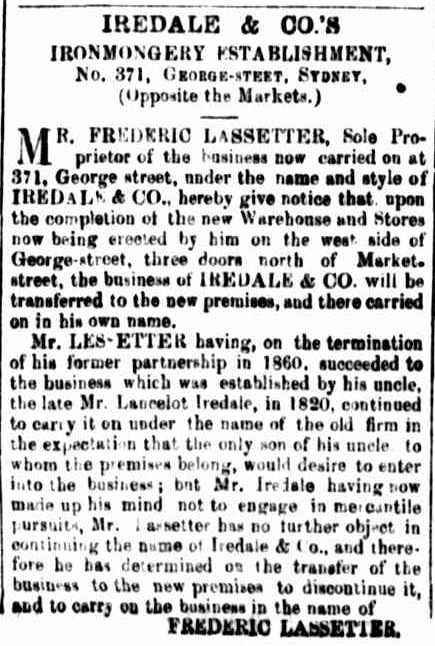
The Courier 2 December, 1863 p. 4.
The new business premises was opened to great fanfare on 7th December 1863, the Governor in attendance, as well as an assembly of politicians and Sydney’s business and social elite. The Sydney press described in detail the complex of warehouses and grand display rooms, extolling the architecture of Edmund Blacket now on display on the western side of George Street.31 Into the front of the building, Lassetter had carved the new business name, along with the mantra which he had personally observed from the first: ‘We lead – competition follows.’
Expansion – of site, stock, staff and sales
The 1863 building became the nucleus for further physical growth over the next thirty-five years, with four later significant expansions or additions, providing nine acres of floor space as part of a site which took in three city blocks and included storehouses, workshops and its own power plant. Elsewhere, in Surry Hills, was a factory to produce bespoke products.
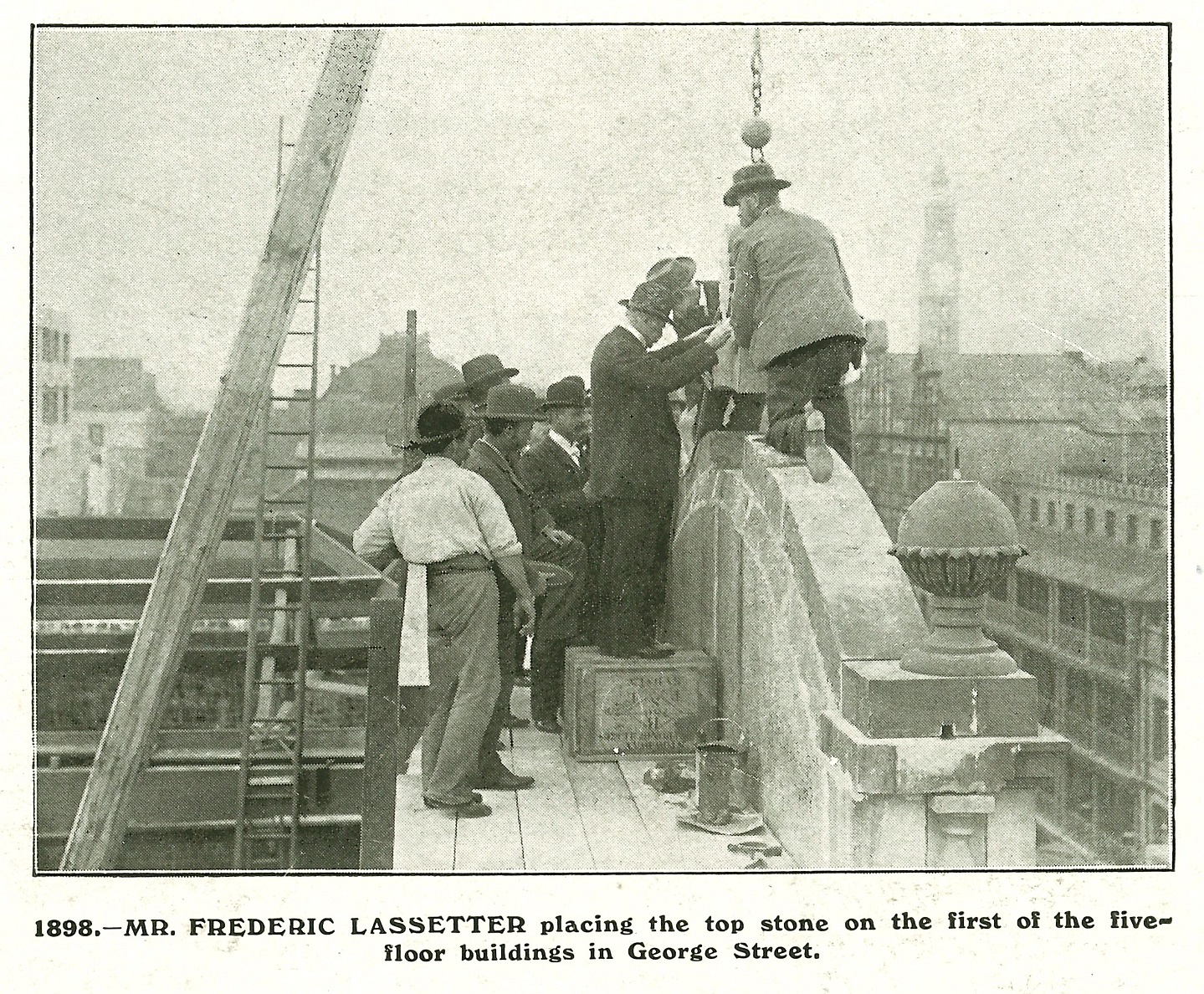
Image from 'Sixty Years an Employer - 1850 - 1910' published in 1910.
The increasing physical footprint of Lassetter's can be seen as a metaphor for Frederic's expansive thinking, and was only one of its outcomes. Lassetter's opened up to become a ‘universal provider’ – a term it was openly using to describe its model from 1900. However, the changes had begun in the 1880s, when the firm added homewares to its staple farm machinery and construction hardware, branching from that base into drapery. Frederic himself gave credit for the final transition to what can be seen as a department store to the urging of his eldest son, Harry, who joined the firm in the early 1890s. The success of Lassetter’s expansion was that it was managed without losing the effectiveness of the firm’s original service, and without neglecting the needs of its original base.
In terms of business operation, Frederic Lassetter led the way in 1878 by forming one of the earliest limited liability companies in Australia. And in the area of marketing, Lassetter's successfully implemented a vast delivery and mail order service, supported by promotional initiatives with wide-ranging outreach. These initiatives took the name of Lassetter’sfar beyond the limits of its bricks-and-mortar retail presence, reaching not only the Australian colonies at large, but also New Zealand and New Guinea.
Lassetter’s monthly catalogue was often upwards of 1,000 pages in length, and interspersed useful information with the presentation of the goods it advertised. It was said by historian Francis Pollon that in country homes across Australia, the Lassetter’s catalogue was ‘placed on the table beside the family Bible.’32
Lassetter’s extended its publishing operations from 1894 with the introduction of Australian Field, a journal aimed at ‘squatters, sportsmen, farm & fireside, etc.' perhaps a reminder that country account-holders were of special interest to the firm, and reassurance that, despite branching into the supply of fine homewares (all advertised in the Field) Lassetter's remained a preferred supplier of all a farmer's or a pastoralist’s needs.
The Australian Field was also a departure from the Lassetter's catalogue, in placing a heavier weight on informative articles and commentary, discussing current affairs, reporting sporting news, providing articles on health and education and expert information on land management. The Field remained in publication until 1906, filling a niche. So ‘universal’ were the publications of Lassetter’s that, preserved now in public collections, these items are considered a reliable and revealing time-capsule of Australian life in the era when this retail enterprise flourished.
During Frederic Lassetter’s lifetime, the history of Iredale/Lassetter business was one of continuous expansion and innovation. By June 1910, when Frederic celebrated the diamond jubilee of his entry into a partnership to run the Iredale establishment, Lassetter's had a staff of 1,000 and a wages bill of £80,000 pa, and enjoyed the loyalty of 100,000 account holders.
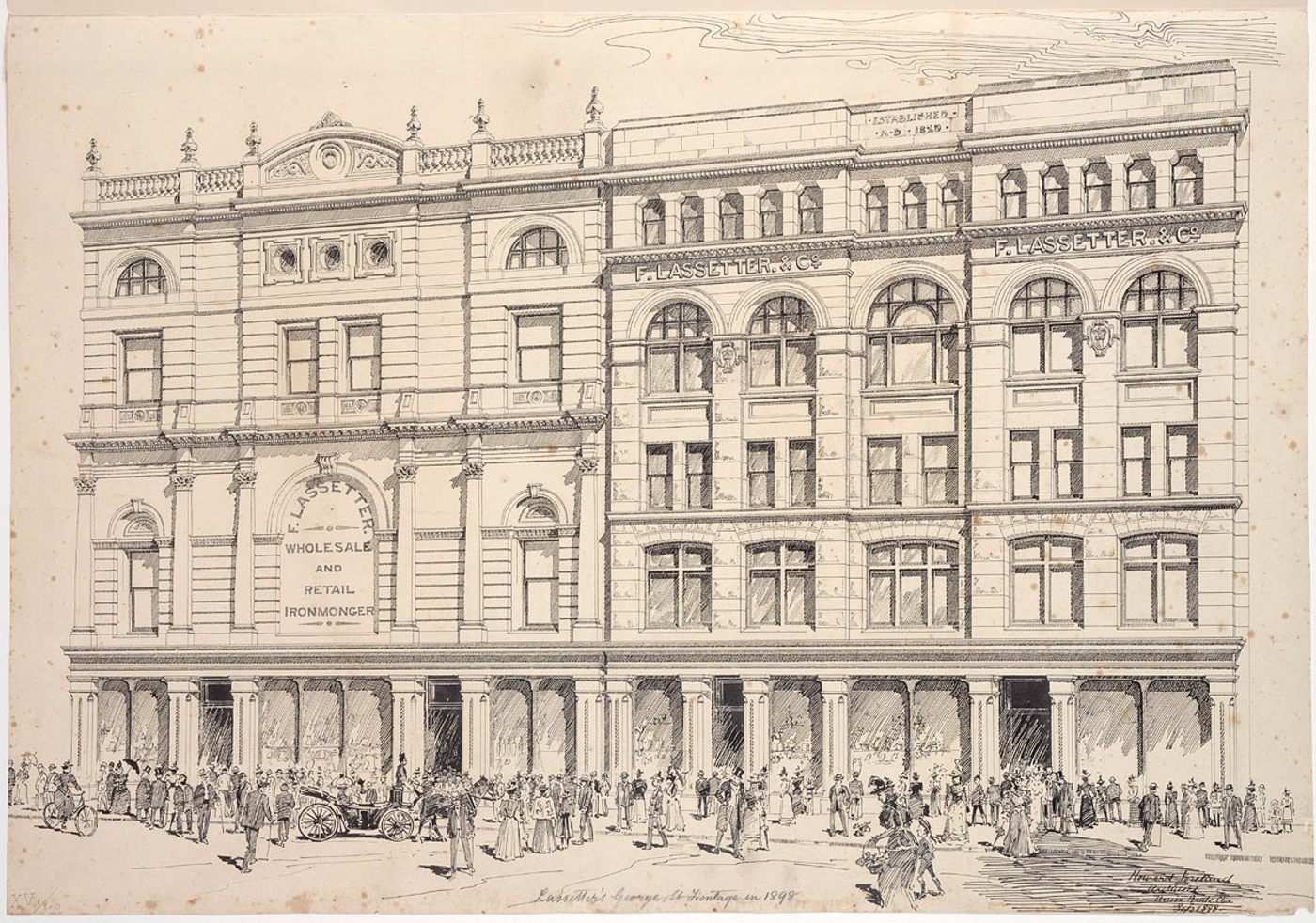
'Lassetter’s George Street frontage in 1898' by R G Howard Joseland. State Library of New South Wales XV1/Sho/Lass/1
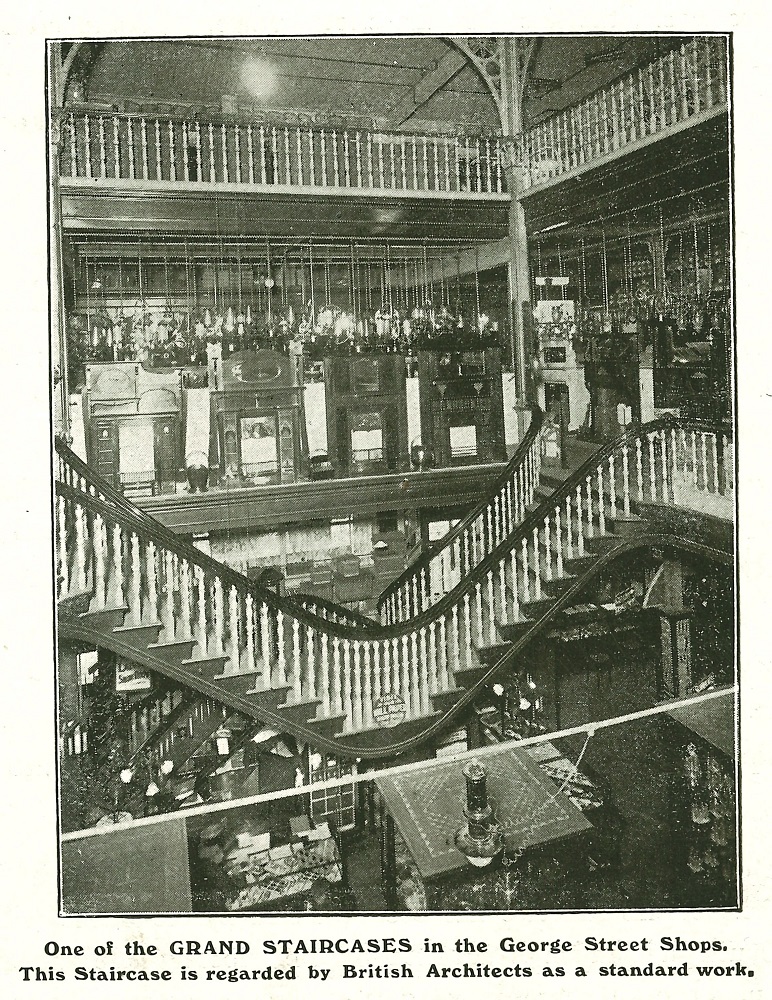
Image from 'Sixty Years an Employer - 1850 - 1910'.
An early employer of choice
At the height of his firm’s success, Frederic Lassetter’s attitude to his employees was considered exceptional. The firm was well ahead of its time in creating both a profit–sharing and a health benefit scheme for its staff,33 and in 1903 engaged willingly with the Shop Assistants Union as part of the Union’s quest to establish a standardised rate of pay for retail workers.
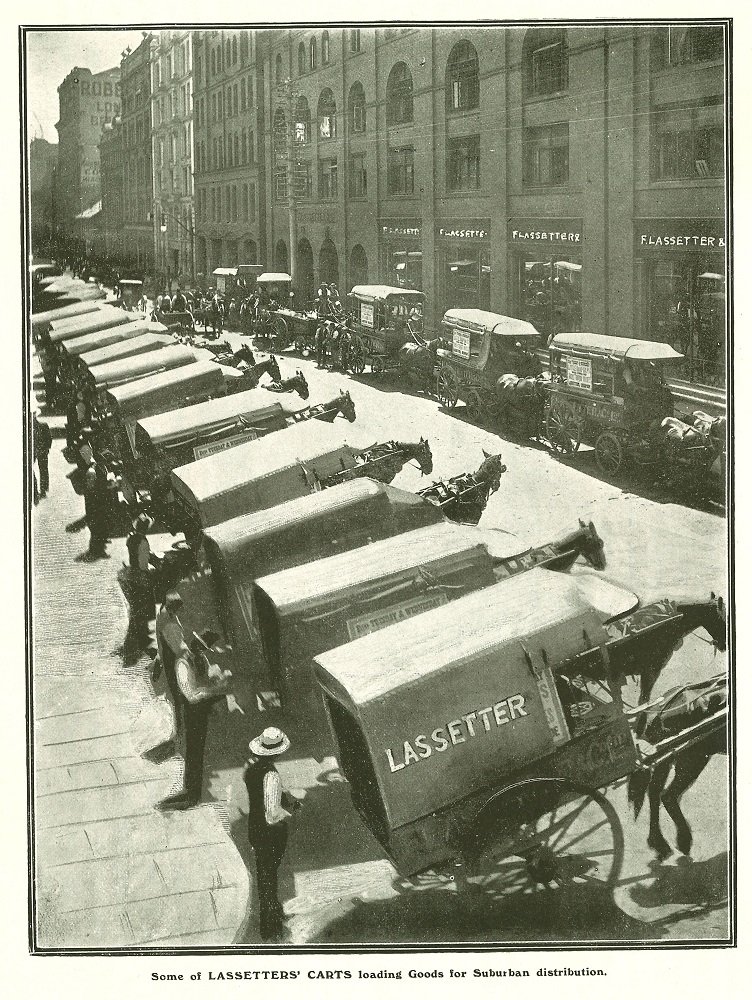
'Some of Lassetters' Carts loading goods for Suburban distribution'. Image from 'Sixty Years an Employer - 1850 - 1910'
An uncomfortable period followed in Sydney’s retail world, when it emerged that the pay scale put forward by the Union was based on its draft agreement with Lassetter’s, a firm which paid more generously than fellow heads of retail wished to match. As part of these tensions, Lassetter’s withdrew its membership of the Master Retailer’s Association (later reinstated).34 Amidst reports of the subsequent challenges and appeals, one newspaper produced the headline:
THE STRUGGLES OF SHOP ASSISTANTS FOR A FAIR DAY'S WAGE FOR A FAIR DAY'S WORK. Saucy Sam Hordern's Skinflint Scale, And Lassetter's Liberal Log.
Truth 10 July, 1904 p. 3.
One twenty-first century interpretation of this period of industrial relations raises the possibility that Lassetter’s management was cynically engaging with the Shop Assistants Union at this time. It is suggested that this was a calculated manoeuvre on the part of the firm, resting comfortably on a reasonable assumption that the Union’s bid for common rule would fail, leaving the Lassetter offer open to rescission.35
While persuasive, this theory does not align with the widespread reporting, accumulated over decades, of what would seem a genuine harmony in staff relations at the Lassetter’s establishment. Retention of staff was another indicator which vindicated the firm’s approach. In 1920, when Lassetter’s celebrated its centenary (calculated from the founding of Iredale’s in 1820) the then head, Colonel Henry Beauchamp Lassetter noted instances of multiple generations employed from certain families, while explaining that the welfare of the staff was a matter that always excited the keenest interest and concern from management. Speaking specifically of his late father, Harry Lassetter said:
He did not like losing any of the employees. He liked to keep the business in the family, as it were…. If, however, an employee struck out for himself … nothing gave him greater pleasure than to hear of an ex-employee’s success.
'F. Lassetter and Co., Ltd.', The Catholic Press 16 September, 1920 p. 29.
Until his death in 1911, Frederic Lassetter enjoyed, on a personal level, remarkably good relations with his employees. At various times, special events were organised in his honour by staff. On one such occasion, a representative speaking for all, declared:
When the poet Burns penned ‘Man's inhumanity to man makes countless thousands mourn' he did not have employers like you in his mind, as you are always ready to extend a helping hand whenever necessary. You are surrounded by a contented and loyal staff, who have the kindliest feelings of regard for yourself.
'A Diamond Jubilee.' The Sydney Morning Herald 10 June, 1910 p. 8.
The final expression of gratitude and respect from his staff came at Frederic Lassetter's funeral, when their numbers alone spoke volumes.
When the cortege moved towards the cemetery it included about 800 persons. Immediately behind the hearse, headed by the departmental heads of the firm, marched the employees.
'Mr. Lassetter's funeral', The Sydney Morning Herald 8 September, 1911 p. 8.
Frederic understood that his employees were critical to the success of his business, and shaped his management of Lassetter's accordingly. A publication produced to mark his diamond jubilee in retail bore a title revealing in itself : Sixty Years an Employer.
The end of a retail era
Frederic’s death came to be seen by many later commentators as the beginning of the end of Lassetter's, and the death of his eldest son Henry Beauchamp Lassetter in 1926 appears to have been the final decisive factor. Frederic had wished to ‘die in harness’ – a gauge of the magnitude of his involvement, and an indication of the corollary impact of his loss. Frederic was granted his wish on 5th September 1911, spared from the knowledge that his firm would survive him for less than 15 years.
When it came, the loss of Lassetter’s caused a sensation. Sydney newspapers covered the closure as avidly as they had reported its earlier triumphant milestones. The Sun posted a photograph, headed ‘Lonely Lassetter's’, showing the deserted frontage with lowered awnings partially obscuring the blank shop-windows. The accompanying text captured the mood:
The stream has stopped. No busy rush of bargain-hunters wended its way along George Street towards Lassetter’s big emporium this morning. The store was closed down practically for the first time on a normal business day, in more than a century. Soon the old name will disappear from the verandah, and others who new [sic] not Lassetter’s will come on the scene.
The Sun 5 May, 1926 p. 11.
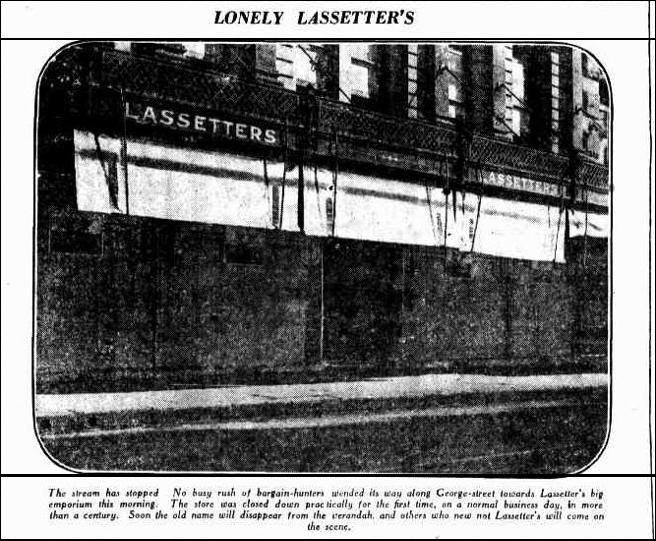
The stock was sold, and the George Street ‘showrooms’ acquired by the Civil Service Stores, which undertook extensive re-building work in 1927, subsequently occupying the premises until the firm's financial collapse in 1930. In July 1933, when the established firm of Nock and Kirby took over the re-modelled building as a new flagship store for its operations, the link was revived between 421 George Street and the original basis of Frederic Lassetter’s business: hardware. And hardware remained the focus on the site for the next fifty-six years, firstly under Nock and Kirby, and extended by the occupancy of BBC Hardware following a take-over by Burns Philp in 1989. Today the site is occupied by a mix of retail enterprises.
When, as a young man, Frederic Lassetter had first moved back to Sydney from Melbourne to enter employment with G A Lloyd, he stayed in the cheapest Sydney lodgings he could find. As his circumstances changed and he acquired a family, and as personal economies became less pressing, Frederic provided a succession of enviable dwellings to house his growing household.
Between the late 1850s and the move to Redleaf in 1889, and punctuated by periods spent abroad, the family variously occupied the landmark residences Eastbourne at Darling Point and Beaulah and Wotonga at Kirribilli. Wotonga, leased by Lassetter from his friend and early mentor George Lloyd, was eventually transferred to the colonial government and today serves as the Sydney residence of the Australian Governor-General. It was a measure of Frederic's rising fortunes and status that tenancy of such property was within his grasp.
Offering similar advantages to all three of these houses, the Redleaf property at Double Bay, with its harbourside setting, spacious grounds and superior appointments would be the first dwelling which Frederic purchased as a long-term family home. Even so, the Lassetters were in residence at Redleaf for several years before Frederic, in 1891, purchased the residue of the lease of William Benjamin Walker’s 1863 house from the Busby family trustees. In 1905, Frederic secured the freehold from the Cooper estate.
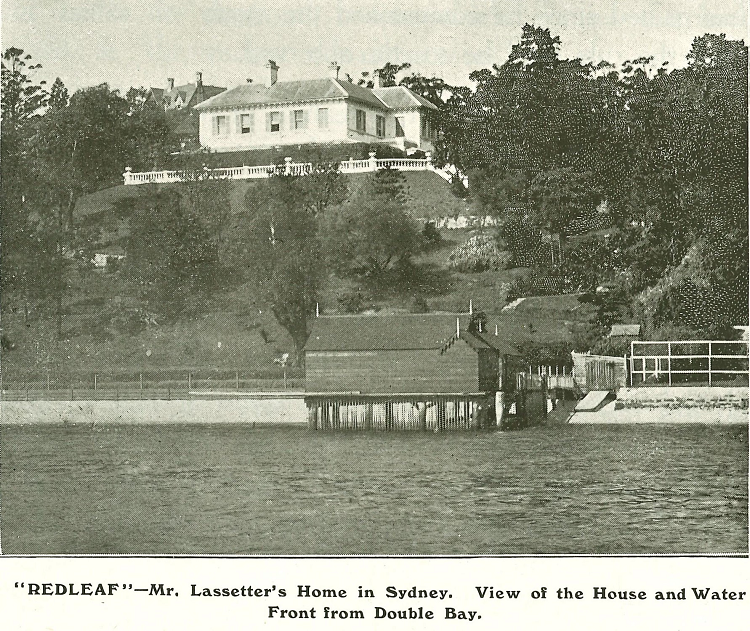
Image from 'Sixty Years an Employer - 1850 - 1910' published in 1910
Over fifty years before, on the 11 December 1852, at the Wesleyan Chapel Surry Hills, Frederic had married his cousin Charlotte Hannah Iredale. Charlotte was the seventh daughter of Frederic's Aunt Kezia Iredale and her late husband Lancelot. It was a double ceremony, shared with Charlotte's sister Alice Jane Erskine Iredale in her marriage with W H Lane.36
Frederic and Charlotte would have eight children, and it is clear that Frederic was a supportive father, although not indulgent, and that his family equally rallied around him in support of his ventures - the main being the firm of F Lassetter& Co. The building of a second home, St Brigid’s, at the family’s Redleaf property, was an example of Frederic's filial support, as the house was built for the use of his son Arthur Bowring Lassetter, and also accommodated other of his offspring as they moved between Sydney and the alternate worlds which engaged them in the Northern hemisphere.
Redleaf was to be Frederic's home for over twenty years. The property was well equipped for the family's pleasure, with a tennis court, a roofed shark-proof swimming enclosure, and a jetty and slips catering to both the leisure of sailing and the launch which, with more practical purpose, carried Frederic to the city every day. The gardens would have given enjoyment to the family as a whole, and especial interest to Frederic's daughter-in-law Elizabeth, wife of Harry Lassetter, whose name during years spent in Bathurst was regularly linked with winning entries in horticultural exhibitions.
The Sydney social pages suggest that Frederic Lassetter lived comparatively quietly at Double Bay, but his adult children entertained from the house. Published reports of occasions when the family opened Redleaf for social events record that the beauty of its setting was exploited to full effect, while the listed guests - predominantly members of the eastern suburbs establishment - were evidence of the Lassetter family's firm footing within the close-knit community of the area. Among his memberships in Sydney, Frederic counted the Royal Sydney Golf Club at Rose Bay, where his daughter-in-law Mabel (wife of Arthur Bowring Lassetter) was well-known as an accomplished golfer. Frederic himself was still golfing at 'the Rose Bay links' when he was 80.
St Brigid’s was built on the eastern portion of the Redleaf property in 1897. The architect, Frederick Moore Simpson, held the chair of Architecture at Liverpool University, England, and while the exact circumstances of this commission are unknown, a year spent in Europe by Frederic and Charlotte, who returned to Sydney in February 1897, may have been a factor in Simpson's involvement. The year of construction was recorded on the since-dismantled chimneys of the house, and confirmation of its completion appears in the minutes of a Woollahra Council meeting on 9 August 1897 : an application from Frederic Lassetter to have kerbing and guttering constructed 'in front of his new house on the New South Head Road.' Two years later, the house was the subject of an approving article in an English construction journal, The Builder.
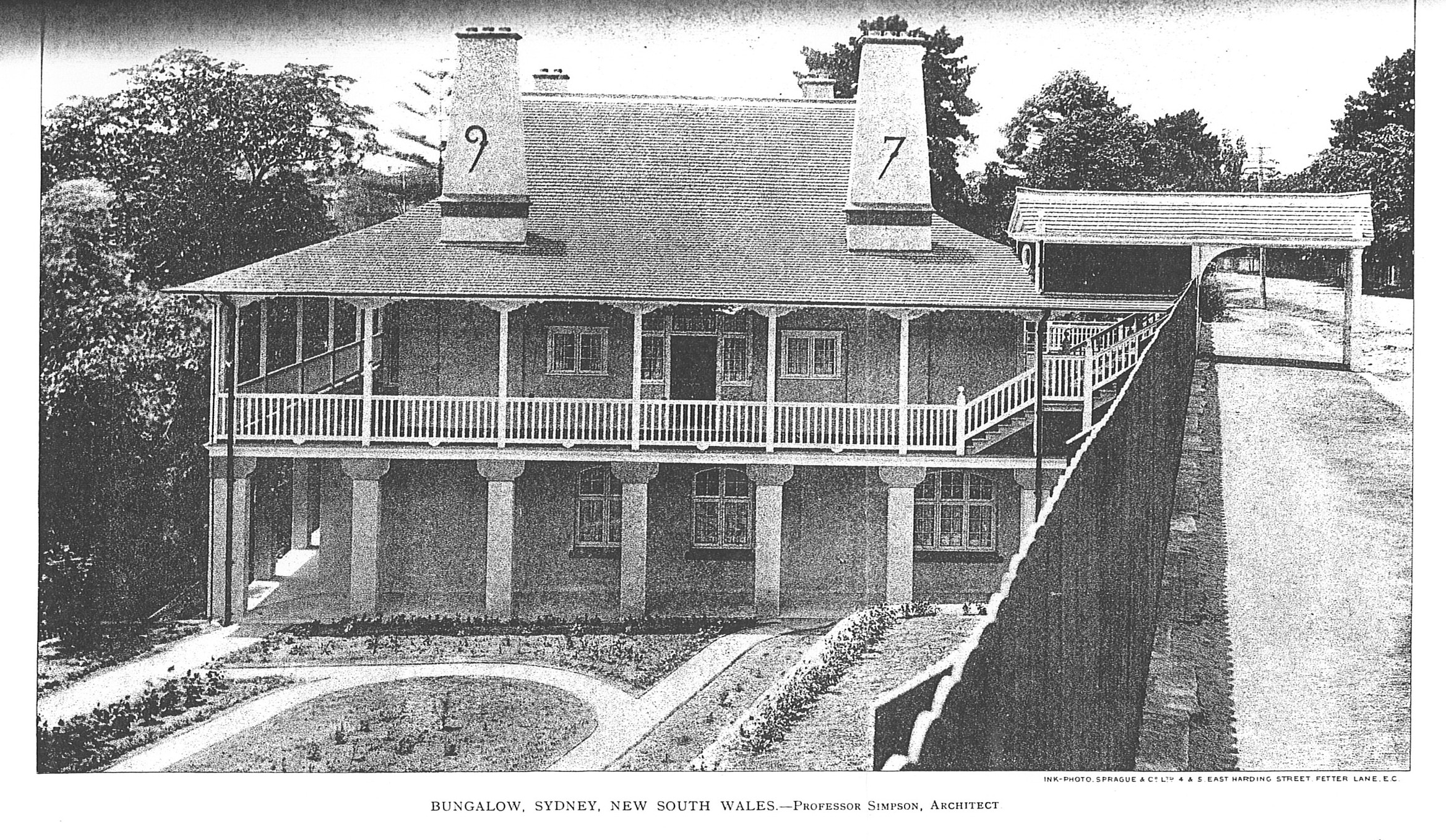
St Brigid's, New South Head Road, Double Bay. Image from 'The Builder' Oct 28, 1899. Captioned: 'Bungalow, Sydney, New South Wales - Professor Simpson, Architect.
St Brigid's fulfilled its intended use as an adjunct family home for some years, with the newly married Arthur Bowring Lassetter - Frederic's third son - being the first in residence. However, the death of Frederic, and the growing tendency of his widow, children and their families to spend increasingly long periods abroad, eventually made their Double Bay property superfluous. In 1913, the site was re-subdivided and the two houses sold on separate titles, to be re-consolidated some four decades later through the common ownership of Woollahra Council, when Council acquired first Redleaf (1941) and later St Brigid's (1950).
In 1947, Council transferred its headquarters from the 1860s Ocean Street chambers in Woollahra to Redleaf Double Bay, while St Brigid's has served in Council ownership as an art centre, the working headquarters for the Petrov Commission, and for almost 60 years as the accommodation for the central library of the Woollahra Library service. Following a Woollahra Council resolution in September 2018, the building was sympathetically restored and re-purposed as the Woollahra Gallery at Redleaf, opening in this new role in November 2021. Between the two former Lassetter houses lies a much-loved area of public open space, set aside for passive recreation. Named Blackburn Gardens after the southerly of the two coves which make up Double Bay, and created from the grounds once shared by the two Lassetter houses, this today offers a peaceful retreat, available to all.
Legacy
In 1910, as Frederic Lasetter celebrated the diamond jubilee of his association with the firm he made his own, the Journal of the Retail Trader's Association of New South Wales wrote that Lassetter's was:
A lasting memorial to the individual effort, untiring energy and indomitable will-power of its great founder.
Journal of the Retail Trader's Association of New South Wales 1910
While Frederic Lassetter’s retail empire did not survive, his legacy was nevertheless his contribution to Sydney’s retail life of his own era, and the enduring impact that his expansive thinking and modern approach to industrial relations gave to the world of Sydney business.
Frederic appears to have been a quiet benefactor on a spontaneous basis to a wide variety of organisations. He was also a man of positive energy, who looked back as an 80 year-old with no regrets, and with much thankfulness for the rise in the overall standard of living which he had witnessed during his lifetime. Of even greater satisfaction to him was the fact that these benefits were, at least in his adopted country, widely enjoyed.
Locally, Frederic Lassetter's once private houses and garden remain in public use, giving pleasure to generations of the local community.
Published
Lech, Michael 'F Lassetter & Co" Dictionary of Sydney.
McKenzie, Joan Silverleaf: the story of Jessie Lloyd, pioneer writer of North Western New South Wales. Coonamble, NSW [privately published by Joan McKenzie] 1986
Nairn, Bede ‘Lassetter, Frederic (Fred) (1828–1911)', Australian Dictionary of Biography, Volume 5, Melb., Melb. Univ. Pr., 1974
Pollon, Frances Shopper and shopkeepers: a social history of retailing in New South Wales from 1788. Syd., Retail Traders Association of New South Wales, 1989.
Sixty Years an Employer Syd, F. Lassetter & Co. Ltd, 1910.
Archival, manuscript, etc
Heathfild, Frances Frederic Lassetter: family history information supplied to Woollahra Library for inclusion in the Local History collection
NLA Trove data base - Newspapers
NSW BDM NSW online index
Sands Sydney Directory
Archival resources of Woollahra Council
Footnotes
1 Inscription on the gravestone for Frederic Lasseter, South Head Cemetery Sydney, Section I, Row 9.
2England , Select Marriages 1538-1973; 1067115 – 2:39W1Q1M
3 England, Select births and christenings 1538-1975 0825376 (RG4 3322
4 England and Wales Non-Conformist and Non-Parochial Registers 1567-1936 Southwark Chapel 409/1827
5 England and Wales Non-Conformist and Non-Parochial Registers 1567-1936 St Giles Camberwell 674/H23.
6 England, Select births and christenings 1538-1975 0825376 (RG4 3322). It seems Matthew and Elizabeth’s second daughter may also have died in infancy, but these details have not been found.
7The Sydney Monitor 16 March, 1833 p. 3.
8The Australian 17 January, 1834 p. 2.
9The Sydney Times 20 January, 1835 p. 3.
10 An April 1836 order published in the Cornwall Chronicle, a Launceston-based newspaper, includes the name ‘M. Lassetter, Launceston’ among the list of local settlers required to file an annual ‘Return of Assigned Servants’ to the Superintendent of Convicts. The Cornwall Chronicle 30 April, 1836 p. 1.
11 The occupation recorded for Matthew in May 1836 in the register of Wesleyan Baptisms, in Launceston, when his daughter Elizabeth was baptised. Wesleyan Baptisms Launceston 1836, Australia, Births and Baptisms, 1792-1981. Salt Lake City, Utah: FamilySearch, 2013 FHL Film number 992594
12The Cornwall Chronicle 29 April, 1837 p. 1; 23 June, 1838 p. 2; 30 June, 1838 p. 108
13The Austral-Asiatic Review, Tasmanian and Australian Advertiser 23 October, 1838 p. 1. 'Report of the Infant School.’ Launceston Courier 29 March, 1841 p. 2.
14Launceston Advertiser 21 February, 1839 p. 2.
15Launceston Courier 16 November, 1840 p. 1.
16The Sydney Herald 16 November, 1841 p. 3. This hotel was located diagonally opposite the later hotel of the same name. Evidence does not suggest it was run as a 'Temperance Hotel' during Lassetter's improbable period of management, so this interlude in Matthew's life remains a somewhat questionable fact and, if factual, inexplicable.
17 'Tasmanian Teetotal Society.’ Launceston Courier 5 December, 1842 p. 2.
18The Courier 26 July, 1845 p. 4.
19 Launceston Examiner 4 October, 1845 p. 4.
20 'Death of Mr. Fred Lassetter.', Truth 10 September, p. 10. 1911
21 Register of Baptisms, Wesleyan Church Launceston, 1836 No 20 Elizabeth Weill Lassetter
22 [Civil Registration records] Launceston ref 492/1839.
23 Launceston Examiner 1 June, 1844 p. 4.
24 Civil Registration records if Tasmania Reference 190/1844; Tombstone and memorial inscriptions of Tasmania/ Tamiot 2nd ed, Genealogical Society of Tas. 1999 p. 2879
25 Nairn, Bede ‘Lassetter, Frederic (Fred) (1828–1911)', Australian Dictionary of Biography, Volume 5, Melb., Melb. Univ. Pr., 1974
26 Civil Registration records of Tasmania, Reference: RG D37/1/6 No 1288.
27 Launceston Examiner 11 May, 1850 p. 8.
28 Empire 22 January, 1855 p. 4.
29Evening News 11 January, 1870 p. 2.
30 'All About People', The Catholic Press 7 September, 1911 p. 22
31 'Opening of Mr. Lassetter's new premises.’ The Sydney Morning Herald, 21 December, 1863 p. 8.
32 Pollon, Frances Shopper and shopkeepers: a social history of retailing in New South Wales from 1788. Syd., Retail Traders Association of New South Wales, 1989.
33 Lech, Michael F Lassetter & Co Dictionary of Sydney 2011
34 Macarthur, Ellen Towards a theory of retail evolution: an Australian history of retailing in the early twentieth century [Thesis – UTS – PhD School of Marketing] 2005 p. 185.
35 McArthur, Ellen Towards a theory of retail evolution: an Australian history of retailing in the early twentieth century [thesis – PhD School of Marketing] UTS 2005 pp. 185-188.
36Bell's Life in Sydney and Sporting Reviewer 18 December, 1852 p. 2.
New plaques are added based on nominations from the community, which are then assessed against selection criteria and researched by a Local History Librarian.
Find out more and nominate a person or event for a plaque.